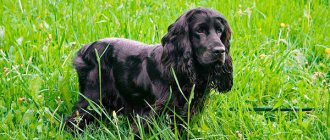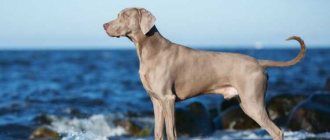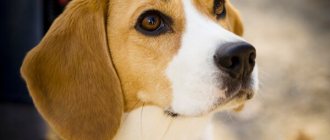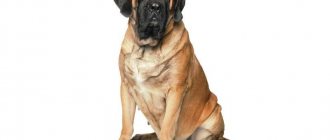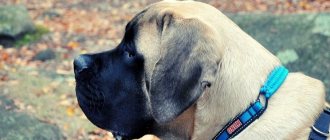| Origin: | England (XVI century) |
| Usage: | hound in a pack for mounted hunting |
| Color: | white with black spots in blush, lemon piebald |
| Dimensions: | height – 58-64 cm; weight – 27-34 kg |
| Lifespan: | 10-13 years |
The English Foxhound is a breed bred on the British island in the 16th century for fox hunting. Also known as Parfors foxhound. Popular in England. The stubbornness and courage of an unsurpassed hunter, intelligence and speed of movement made this breed popular. English foxhounds became the ancestors of similar dogs in other countries (including the famous Russian pinto hound).
Breed standard
The English Foxhound, with all its variety of subtypes, has the following general standards:
- elongated muzzle with a wide and rounded skull;
- a regular scissor bite with a full set of incisors and strong jaws;
- brown or hazel color of expressive eyes;
- drooping long ears with rounded ends;
- smooth, long neck without folds or wrinkles;
- wide and developed lower back;
- the chest is not muscularly massive, but it is quite deep;
- the tail is raised and slightly curved;
- the paws are well developed, they are strong, straight and strong;
- the shoulders are powerful, but not bulky;
- different colors, with spots, the color of which is often black;
- The coat is short but dense.
The description of the breed and numerous photographs demonstrate the strong and harmonious build of the English Foxhound with smooth, free and fast movements. Characteristics of the breed suggest the height of females from 58 cm, males - from 62 cm with a weight that rarely reaches 30 kg.
Description of the appearance of American Foxhounds
According to the standard, the American Foxhound should be lean, lightly boned, with a stretched body. Distinctive features of appearance are a slender muscular body, thin long limbs, wide long ears. The muscles are flat, dry, the skin is elastic and fits tightly.
Males are larger than females, the average size is 60-64 cm, show animals can be up to 71 cm. The height of females usually does not exceed 61 cm. Dogs weigh 29-34 kg, depending on height and gender. But the weight of an individual used for hunting should not exceed 21 kg.
Head
The head is elongated, wedge-shaped, wide between the ears. Skull with a pronounced occipital protuberance. The transition from the forehead to the muzzle is moderately pronounced. There are small folds on the muzzle. The bridge of the nose is straight. The lips are dark and cover the lower jaw. The teeth are strong, scissor bite.
The nose is large and black. The eyes are small, oval, and widely spaced. The look is a little sad. The ears are wide at the base and set low. They hang down to the neck and fit tightly to the head.
Torso
The neck is long, muscular, without folds or dewlap. The withers are well developed, the chest is narrow but deep, the back is straight. The loin is wide, the croup is slightly sloping, the stomach is tucked. The tail is long, saber-shaped, and continues the line of the back. Stretched back or sticking up, never lies on the back.
Limbs
The forelimbs are straight, slender, parallel. The shoulder blades are set obliquely, pressed to the back. Elbows point back. The hind limbs are muscular, allowing the dog to accelerate well. The hock joints are moderately pronounced. Paws with strong claws, collected in a ball.
Coat and color
The coat is thick, hard, and of medium length. The coat fits tightly to the body, there is little undercoat. The most popular color is tricolor. The main tone is white, with brown and black spots on it. There are pure white dogs, as well as red and brown ones.
Photos complement the description of the appearance of these dogs:
Character
The English Foxhound has a friendly and sociable character. Dogs of this breed are curious, intelligent and very attentive to everything that surrounds them. They are distrustful of strangers, but they love and protect their owner’s family.
The English fox hound has an excellent sense of the pack. With other pets, even cats, the Foxhound is friendly and playful.
The English Foxhound may begin to hunt small pets, so it is better to limit their interaction.
These dogs are careful around children. They are tireless and take part in all active children's games and pranks.
The sociability of Foxhounds is manifested in a loud, booming bark, which is genetically determined. Barking helps in hunting, but in keeping it can become a problem.
History of the origin of the American Foxhound breed
The breed originated in the 17th-18th centuries in America. These dogs originated from English Foxhounds, an ancient hunting breed. They were bred specifically for hunting, to track and pursue prey. At first, breeders cared about the purity of the breed, but gradually they began to cross them with Irish and Virginia hounds, greyhounds, so that they were more suitable for rough terrain.
The dogs turned out to be faster and more resilient. Compared to their English ancestors, American Foxhounds are closer to hounds. They are slimmer, with long limbs. The breed began to be called the American Fox Hound, as it was used mainly for fox hunting. You can use them to hunt raccoons, coyotes, possums, wild boars, even bears.
The breed was recognized by the American Kennel Club at the end of the 19th century. But they were registered in the International Film Festival only in the second half of the 20th century. People began to learn about these dogs in other countries, but the breed is widespread mainly in the USA. She is even the symbol of the state of Virginia.
Features of maintenance and care
The Foxhound dog breed is unpretentious. This is a pack dog, so it is best to keep several hounds at a time. The peculiarities of keeping them are that foxdogs need to be walked for a long time, like any hunting dog.
Walk
Walking on a leash is not suitable for a Foxhound. He needs space to be able to release pent-up energy. It is best when the owner is interested in hunting and uses the dog for its intended purpose, periodically training the pet and developing in it the natural instincts of a hunter. But you should be careful, as a fox hound may get carried away while walking and follow the animal’s trail.
Combing
Grooming for the foxhound dog's coat is minimal. Twice a year they shed profusely. During this period, dogs should be brushed daily to speed up the process. The rest of the time, once a month will be enough.
Bathing
You should not bathe your Foxhound frequently. Only if necessary, if the pet got very dirty during a walk. If the dog lives in an enclosure with a warm booth, it will be enough to wipe the fur with a dry cloth after a walk.
Feeding
With natural feeding, you will have to additionally give your English Foxhound a complex of vitamins. If the choice is made towards specialized feeds, then this will not be required, since everything necessary is already included in their composition.
The Foxhound is an active dog, so it expends a lot of energy. The diet of a pet of this breed should be selected taking into account its mobility.
Pros and cons of the breed
| pros | Minuses |
| May exhibit guard qualities | Heavy seasonal shedding |
| Gets along well with children | No pronounced protective qualities |
| Low maintenance | It is not advisable to keep cats |
| Suitable for agility | Requires a lot of physical activity |
| Has good hunting qualities | Reluctant to train |
| It is not advisable to live in an apartment |
Where to buy and price
Buying an American Foxhound puppy in Russia is quite difficult. Local nurseries do not breed them, so future owners can either purchase the baby from their own hands or fly to another country to get it. The price starts from about 6,000 if a small puppy is purchased through a private advertisement. The cost of a sterilized dog with documents can cost 15,000-30,000 rubles.
When buying an American Foxhound, it is important to remember that this is not a domestic dog that needs peace and affection. He has a hunting instinct since infancy, and hunting is his greatest passion. Therefore, it is recommended to own such an animal only to owners who decide to use it for its intended purpose.
Health
The English Foxhound has excellent health, which has been improved over several centuries of selection. There are practically no hereditary diseases in the breed. On average, Foxhounds live from 10 to 13 years.
Possible diseases
Thrombocytopenia is a breed health problem that occurs occasionally.
When choosing a puppy, you should make sure that his ancestors did not suffer from hip dysplasia.
It is very rare, but such an unpleasant hereditary disease as von Willebrand disease also occurs. Sometimes English Foxhound dogs can suffer from eye diseases.
Vaccinations
Foxhounds should be vaccinated once a year against rabies and a range of other infectious diseases. This is especially true if the dog is used for hunting, because wild animals can be carriers of a variety of infections.
Periodic treatment of your pet against parasitic insects and helminths is also required.
Training
The English Foxhound, like any other hunting breed, requires regular support for its instincts and skills. This dog responds very well to firm and active training due to its loyalty to its owner and its keen, inquisitive mind. Usually there are no problems with training or learning to hunt, the main thing is to do it regularly and intensively.
The English Foxhound is the epitome of strength, grace, intelligence and an easy-going, playful nature. This breed is best owned by energetic people who love traveling , hunting or cycling or walking, that is, those who are able to provide these dogs with an active lifestyle.
If you have anything additional to share about the English Foxhound, then leave your comments or reviews that will help future owners understand this noteworthy breed.
How to choose a puppy
The first thing when choosing a puppy is to focus on the conditions in which the litter is kept. The baby must be strong, active and well-fed.
You should not buy a puppy before two months of age. It is better to choose an animal in person rather than online. The puppy must have all breed standards - this should be checked immediately, paying special attention to the bite, the number of incisors, the proportionality of the build and the shape of the paws, which should be straight.
Before buying, you need to look at the documents for the dog, check the pedigree of the parents and the presence of the necessary vaccinations.
How to walk a foxhound?
The American Foxhound requires regular exercise and long runs at high speed. The best pastime for them is jogging through the forest; in extreme cases, you can provide them with free walks during the day. But these active athletes will definitely not have enough quiet 20-minute walks in the morning, which owners organize for less active dogs.
Proper calculation of daily physical activity allows you to keep your pet in shape.
Because of their long legs, Foxhounds can easily overcome obstacles and run very quickly. But if the dog doesn’t get enough physical activity, he will quickly get fat and begin to have difficulty moving.
Teaching your foxhound that food doesn't last forever will help keep his digestion normal.
Important! You shouldn’t leave your pet at home alone: a dog full of untapped energy can create such a mess that the owner will have to throw out half of his things. If you leave a Foxhound alone in a summer cottage, he will quickly learn to open the valves and take an independent walk. Only regular exercise can cure him of such habits.
Hunting with a Foxhound
During the hunting process, the American Foxhound is used in four different ways, which require different levels of training and skills:
- Field trials where Foxhounds compete as hounds against other hounds. Here their reaction speed and efficiency are tested.
- “Gun” pursuit of foxes, in which the dog drives the prey, preparing it for a meeting with the shooter. The hound is required to run slowly and have a loud bark in order to chase the fox.
- Track hunting, where foxhounds appear as fast hounds. The dog simply tracks the game, using its speed and ability to carry out long-term exercise.
- Hunting hounds in a team. From 15 to 20 dogs participate. As a rule, a whole community of breeders or an association of foxhound lovers participates in such mass hunts.
Gradually, the foxhound moves from the status of a hunter to the role of a companion and guardian of the family.
Today, the American Foxhound is gradually losing its narrow specialization as an assistant in hunting. It is increasingly being domesticated due to its close coexistence with humans, which was initially unusual for the dog’s nature. Now the Foxhound is perceived as an energetic pet that everyone in the family, including small children, goes crazy for.
Nurseries
The English Fox Hound is a fairly rare breed outside of Britain. There are now about 300 working packs on the island where puppies can be purchased. A number of packs of Foxhounds can be found in Germany and Canada. But in Canada, English foxhounds are often mixed with American hounds, so the breed is rarely preserved there in its pure form.
People with an energetic personality type should buy an English Foxhound. This is a working breed, so this dog is not suitable for the role of just a pet. In addition, there are also difficulties in content. The animal requires excessive mobility, flocking, and frequent and long walks. However, for a keen hunter living in a country house, this is a suitable pet, a faithful assistant, and a friend.
Dossier
Other possible names: English foxhound, parfors foxhound, English parataya hound. Adult height: 57-65 cm. Weight: 26-36 kg. Characteristic color: lemon piebald, white with black spots in blush. Coat length: short, close-lying. Life expectancy: 11-15 years. Advantages of the breed: friendly, hardy, energetic, independent, determined, gets along well with children and pets. Easily withstands exhausting jumps over rough terrain with frequent obstacles, while easily developing an average speed of 20 to 25 km/h. Difficulties of the breed: constant support of an active lifestyle. The scent of this breed is slightly weakened due to the fact that the fox, which is the main object of hunting, has a rather pungent odor. Average price: approximately from $400. Classification:
- group: hounds and related breeds;
- section: hound;
- subsection: large hound.
Caring for Drahthaars
The Drathaar is a fairly unpretentious breed. A dog can live either in a house or apartment, or in an enclosure. She is also not particularly picky about food. You can bathe your dog with shampoo 2-3 times a year, or you can not do it at all. As for the claws, most often their trimming is not required for the simple reason that they grind down on their own.
If the dog's owner is a great esthete, then caring for it can be made more civilized. For example, do regular examinations of the ears, eyes, paw pads, partitions between the toes, and strengthen antiparasitic measures to prevent infection by helminths and ticks. You can also constantly monitor the appearance of the coat. This is especially true during the molting period or if the dog regularly takes part in exhibitions.
It is important to understand that the structure and thickness of the coat varies among different representatives of the breed, which, in fact, determines the severity of shedding. For the animal's coarse and long fur, regular brushing is necessary. If this is not done, excess undercoat may form, and the guard hair will not fall out completely during the molting process.
It is highly advisable to trim the hair on the head of puppies and juniors that is too soft before the age of one year. The same applies to too long hair, because it will greatly interfere during the hunt.
If this is not done, then excess undercoat may form, and the guard hair will not fall out completely during the molting process. It is highly advisable to trim the hair on the head of puppies and juniors that is too soft before the age of one year. The same applies to too long hair, because it will greatly interfere with hunting.
Drathaars are not at all afraid of water and love to swim in bodies of water, so you should not deprive them of this opportunity, since a constant excess of energy requires an outlet. Dogs also love to engage in any sport: running, jumping, playing catch.
Diseases and health problems
The life expectancy of terriers is 10-12 years. The breed standard defines Foxes as healthy and hardy dogs. Good genes allow dogs not to experience health problems, and vaccination minimizes the risk of disease. Both smooth-haired and wire-haired foxes are equally resistant to disease.
But, despite good immunity and proper care, animals can still get sick, as they are at risk of certain ailments:
- Eye diseases, including cataracts. If you think your pet's eyes are cloudy or he has difficulty seeing, take him to the vet immediately, otherwise he may lose his sight;
- Skin diseases that can occur as a result of mites. For treatment you will need appropriate medications, and for prevention - special shampoos;
- Peters disease is a disorder of the blood supply to the femur. If drug treatment is ineffective, surgical intervention is used;
- Metabolic disorders are possible. Due to a sedentary lifestyle, the animal may develop diabetes or become obese. This can be prevented by proper nutrition and an active lifestyle;
- Melanoma;
- Muscle weakness;
- Distichiasis.
Sometimes four-legged animals may suffer from deafness or epilepsy. Studying the puppy's pedigree will help you avoid these problems, since these ailments can be transmitted at the genetic level. Poor tolerance to medications can trigger an allergy attack. By following all the recommendations for caring for your pet, you can ensure it has a long and healthy life.
English Foxhound
Among dog breeders, this type of hound dog is usually called “foxdog”. The breed, despite its ancient origins, has not lost its glory to this day.
Hunting dog breeds also include: Russian piebald hound, Jagd terrier, Afghan hound, Russian hound, Russian greyhound, American cocker spaniel, Parson Russell terrier, smooth fox terrier, hunting spaniel, Thai Ridgeback, small English greyhound, Welsh terrier, basset hound , Estonian hound, Basenji, Irish setter.
The younger generation was distinguished by the thickness and length of its coat, height and body structure. Breeders, obsessed with the desire to get puppies suitable for baiting foxes, continued to experiment.
At the same time, the external characteristics of the animal, the color of the withers, as well as its endurance, speed of movement and psychological compatibility with the pack were taken into account. Those English Foxhounds that we are accustomed to did not appear immediately
At first there were dogs with the external features of Staffordshire, Cheshire, and Lancashire. All of them were united by similarities in character and volumetric dimensions. A real breakthrough to perfection was achieved by the Worcestershire and Bedforshire owners of fox dogs.
Did you know? It turns out that dog nose prints are unique, just like human fingers. Criminologists often use this feature when solving crimes involving dogs or their owners.
.
dogs
Selection work took about 4 centuries, and in the 19th century, improved puppies of the current smooth-haired hunting hounds were presented to the world.
It was then that the breed received triumphant recognition and was appreciated not only in Europe, but also in the United States of America and Canada.
According to breeding standards, the description of the breed and character of the English Foxhound must clearly meet the following requirements:
- the weight of the animal is within 30-36 kilograms;
- height at the withers for boys is 58-64 centimeters, for girls - 53-61 centimeters;
- medium-sized head with dark color on a wide and flat area, as well as with a blurred transition to the muzzle;
- elongated muzzle with hanging wide ears, large nostrils, medium-sized brown eyes;
- The body of purebred dogs is knocked down and slightly elongated, ideal for high-speed pursuit;
- the neck is not thick, long;
- shoulders are light;
- chest deep;
- the back is wide and the loin is slightly elongated;
- the hounds' legs are long, distinguished by powerful bones and developed muscles;
- rounded paws;
- the tail is sickle-shaped, set high;
- the coat is thick, hard and short, in healthy animals it is shiny;
- The color comes in three and two colors (red-piebald with black and red-piebald).
Important! The English fox hound behaves like the leader of the pack. Therefore, its owner must have a strong and strong-willed character
Only with calm, but at the same time tough training, the dog will begin to cooperate with the owner.
They have a strong voice, excellent eyesight and average sense of smell. When chasing an animal, hounds rely more on their eyes and try their best not to lose sight of a potential victim. Not even water can stop them.
In their homeland, hunters use such dogs only for catching foxes, but in France they are in demand for chasing wild boars and deer.
Ukrainian Foxhound owners describe their pets as good hunters, watchdogs and nannies. The animal is very friendly, gets along with children, puts up with neighboring animals in the house and is very devoted to the family.
Such a dog will play with the little ones and, if necessary, protect the house from strangers. It is characteristic that causeless aggression is not at all characteristic of this breed.
Dogue de Bordeaux, spaniel, dachshund, Staffordshire terrier, bichon frize, and poodle also get along well with children.
Important! Experienced dog breeders advise residents of rural areas to acquire hounds. The recommendation is based on the fact that the dog prefers freedom and space where there is a flock, a kennel yard
Foxcats do not like city life in cramped high-rise buildings, nor do they like loneliness or inaction.
Diseases and health problems
The life expectancy of this breed is not very long; dogs live only up to 10 - 12 (14) years. The average duration, according to the English KC, is a little over 8 years. The main cause of death is gastric volvulus (34% of deaths), followed by cancer (27%). Cancer occurs as often as in other breeds, but kills bloods at a younger age - on average about 8 years.
Breed diseases:
- Aortic stenosis is a narrowing of the outflow channel of arterial blood from the heart, which causes shortness of breath, weakness during exercise, and fainting;
- Gastric volvulus occurs when a dog that is full of food suddenly jumps. The stomach twists, gases accumulate in it, and inflammation begins. Only urgent surgery can save you. Therefore, the dog is fed an hour before a walk; after eating, it should rest;
- Turning of the eyelids (entropion). When the eyelid turns inward, the hair begins to irritate the cornea of the eye. This provokes conjunctivitis and corneal ulcers. Treated promptly;
- Skin cancer.
In addition, one of the common diseases is dermatitis, which develops in the folds of the skin. Excess weight with weak ligaments provokes inflammation and other disorders of the musculoskeletal system; a special diet with chondroprotectors is required. Dysplasia of the joints, elbow and hip, hereditary problems in bloods, as in many breeds.
The increasing incidence of food allergies, which indicate a deterioration of immunity, and mental problems can be explained by breeding defects: unprofessional pairing, frequent inbreeding and poor litter culling.
Breeding American Bandogs
American Bandogs can be mated at two years of age, both in males and females. Early dog matings are not recommended; they undermine the health of not only the parents, but their offspring. One of the most important aspects here is the selection of a worthy partner, which is not so easy to do, because bandogs are considered an unrecognized breed and checking their origin is a troublesome matter. Partners must be healthy, without genetic abnormalities. Before mating, it is worth deworming them.
From the 11th to the 15th day of estrus, you can begin the mating process. This should be preceded by excellent walking of partners, who do not need to be fed. Acquaintance should take place on neutral territory, let the dogs take a closer look, run around, and communicate. Then you should move into the domain of the male dog so that he feels confident and strong.
It is advisable that the owners be present during mating, because dogs may need help when the owner is nearby, the animal feels calmer. Owners should be quiet so as not to scare the dogs. To be sure, a repeat (control) mating is recommended, which can be done within 24 to 48 hours after the first mating. If everything goes according to plan, then the female becomes pregnant.
The duration of pregnancy ranges from 56 to 72 days. It is better to mark the day when the mating took place in order to know about the exact duration of pregnancy, the duration of which depends on the number of puppies (the larger the litter, the longer it will be). Young females give birth to few puppies. Closer to 3 or 4 years of age, their fertility increases, and then declines again.


